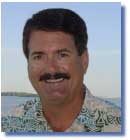|
 Raised in upstate New York, Clark attended college in South Hampton, a community bound by its connection to the sea and its crabbers and oystermen. "They'd give you a shellfish license for free, but you had to know the regulations and they enforced them," says the director of Tampa BayWatch, who hopes to rekindle a little oyster love right here in Tampa Bay. Raised in upstate New York, Clark attended college in South Hampton, a community bound by its connection to the sea and its crabbers and oystermen. "They'd give you a shellfish license for free, but you had to know the regulations and they enforced them," says the director of Tampa BayWatch, who hopes to rekindle a little oyster love right here in Tampa Bay.
The non-profit group, which enlists volunteers for bay restoration projects, is building oyster reefs at select sites to aid in the bay's recovery.
Oyster beds not only stabilize bottom sediments, they also provide rooting structure for corals, barnacles, sea squirts and anemones, which in turn attract fish - and fishermen. But most remarkable is their water-filtering ability. A single oyster can filter two to 10 gallons of seawater an hour, removing suspended sediments and algae. "When you float over an oyster bar at high tide you can almost see how much cleaner and clearer the water is," says Clark.
No one knows for sure how many oyster reefs have been lost in the bay, but declines have been significant as near-shore areas have been dredged and filled for development. Naturally occurring oyster beds grow in shallow waters with freshwater input.
Using fossilized shell mined in Sarasota, BayWatch has installed 12 reefs in the past three years. At Whiskey Stump Key, they teamed up with Audubon to fortify an eroding shoreline, building a series of oyster bars and planting grasses. Proof that locals know where the fish are, Clark says, "Eight months after we built it, I went out there to fish and there were already three boats over the bars."
The largest project so far - involving more than 20 tons of shell - was installing a wave break on the west side of Palonis Park in Tampa to protect the shoreline from storms and heavy boat traffic. Three 40-foot, four 50-foot, and a 100-foot bar were constructed of clean, three-inch oyster shell mounded in a row parallel to the shoreline with space between each to allow water flow.
"You wouldn't believe how many tons of oyster shell a dozen boy scouts high on donuts can shovel," says Clark.
Up next, BayWatch crews will help construct two 100-foot bars off MacDill Air Force Base. Another 900 oyster domes, smaller units designed for placement in deeper waters fronting seawalls, are planned nearby.
Reefs are monitored every six months for two years, generating feedback used in the design of future projects. It also helps trackers keep an eye on invasive species like the green mussel, which can spread like wildfire after attaching to hard surfaces. "We have found that when the oyster bars first go in the water we get a few green mussels growing on them, but after about four months, they seem to get eaten off," says Clark.
Build a Bar
Ideal sites include lower tidal areas along eroding shorelines where there has been substantial habitat loss. After a project is permitted, crews stake out the area, then the shell is delivered to boat ramps and readied for transport to the site by donut-fueled volunteers who shovel shell into five-gallon buckets or bags.
Volunteers work alongside staff to install the reefs, which are created by placing shell-filled bags end to end in rows that stick up about eight inches. Oyster reefs are planted in waters deeper than salt marsh grass but shallower than seagrass beds. It takes about 10 tons of shell to construct a 100-foot reef.
The new hard bottom surface provides an excellent platform for settling spat, or oyster larvae, eventually building on top of itself to create "oyster condominiums" for crabs and other animals.
Sadly, despite dramatic improvements in water quality, most of the bay is closed to shellfish harvesting because of the risk of bacterial contamination from pollutants entering in stormwater runoff from the land. While two areas of the bay - near Fort DeSoto in Pinellas County and in portions of Tampa Bay near Manatee County - are conditionally approved and regularly tested, they are often closed following heavy rains.
"You can't miss what you don't remember," says Clark. "Since we lost the resource a generation ago, people today just don't have an appreciation for it."
Turning the tide won't be easy, but BayWatch is winning converts reef by reef.
|